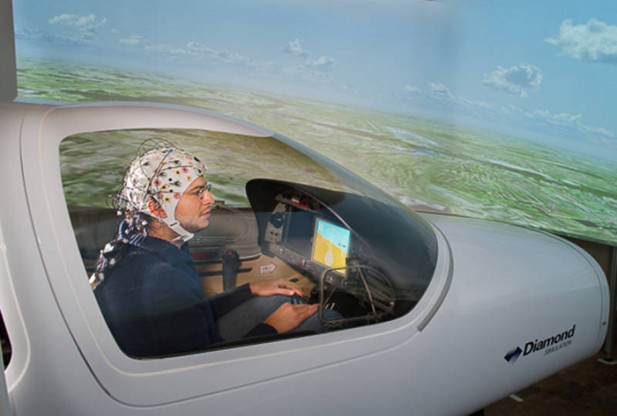
Researchers at the Technische Universität München (TUM), under the guidance of Professor Florian Holzapfel, are developing methods for even untrained laypersons to strap into the cockpit, soar into the clouds and return safely again to the surface of the Earth. The method, involving a white skull cap and several wires, relies upon electroencephalography (EEG) readings from specific brain regions used by traditional pilots in captaining an aircraft. The EU funded project, "Brainflight," is a long-term study intended to make flying even more accessible to the average person.
"With brain control, flying, in itself, could become easier," explained Tim Fricke, one of the project leads at TUM, in a recent statement. "This would reduce the work load of pilots and thereby increase safety. In addition, pilots would have more freedom of movement to manage other manual tasks in the cockpit." This last point is true because, with mind controlled thought, the pilot would not be restricted by having to maintain contact with flight control devices or pedals.
Still in the early stages, the study has already experienced its first major breakthrough: They have shown how mind controlled flight is not only a possibility, it is a reality. The team brought in seven test subjects with varying degrees of piloting knowledge, including one subject who had absolutely no cockpit experience at all. The subjects showed that with the EEG skull caps on, they could fly a flight simulator with amazing precision. "One of the subjects was able to follow eight out of 10 target headings with a deviation of only 10 degrees," reported Fricke.
The next phase the team will address is how pilots will recognize and deal with flight tension and stressors they traditionally experience through manual control of the aircraft. This feedback is missing when using brain control. Going forward, they will seek out alternative forms of feedback that will let a mind control pilot know when the aircraft is being pushed too hard.
As the TUM researchers are quick to point out, the EEG reading is key to mind controlled flight. A partner group of researchers at Team PhyPA (Physiological Parameters for Adaptation) at the Technische Universität Berlin developed an algorithm that would translate the EEG reading into useful control commands.
The algorithm, it should be noted, was designed only to recognize the clearly defined electrical brain impulses that are required for the flight exercise. "This is pure signal processing," stated Fricke. "Mind reading is not possible."
This technological advance is obviously not being loaded into cockpits just yet, but you can be sure it is far closer than you may think. The research team is presenting their results this upcoming September at the "Deutscher Luft- und Raumfahrtkongress" (German Flight and Aerospace Congress). All funding for the research has been through grants provided by the European Union Seventh Framework Programme.



Reader Comments
to our Newsletter